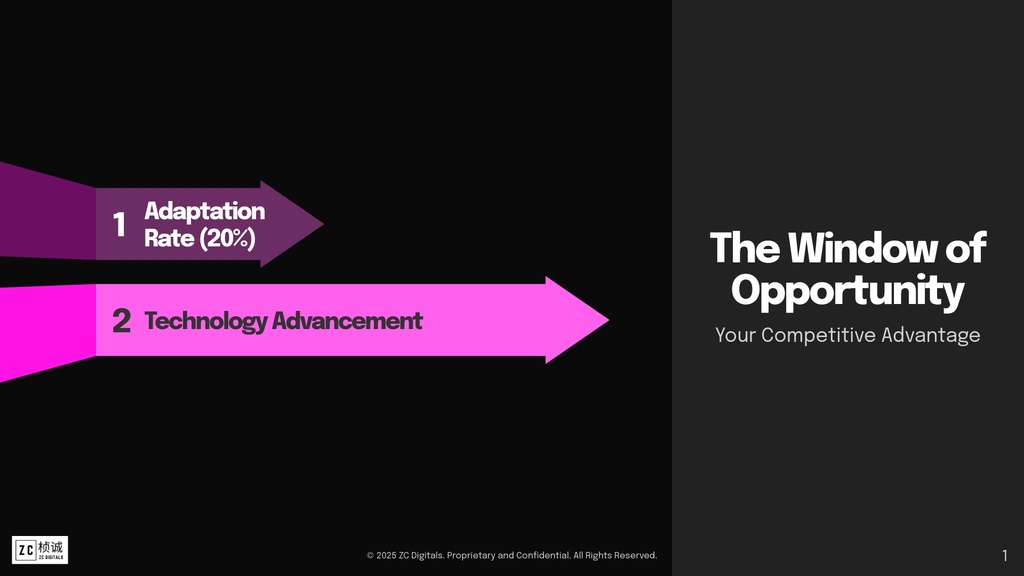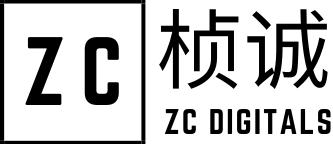“I’ll wait until AI technology gets better.” How many times have we heard this? Or even thought it ourselves? It sounds sensible, right? Why waste precious time and resources on immature AI tools when a perfect version is just around the corner?
This thinking, while common, is dangerously wrong. In today’s rapidly evolving AI landscape, waiting isn’t just cautious – it’s often fatal to your competitive edge.
The Critical Gap: AI Advancement vs. Adaptation

Imagine this: A new AI technology – large language models, generative AI tools, automation platforms – reaches 100% of its current potential. It’s out there, capable of doing amazing things right now. But across the industry, the actual adaptation rate – how much businesses are actually using this AI effectively – might only be 20%.
There’s a massive 80% gap between what’s possible with AI today and what’s being done. This gap is where the game is won or lost.
While you’re waiting for that mythical “perfect” AI version (which might never come, as AI keeps evolving), your competitors who are embracing the current 100% capability, even with its quirks and limitations, are leaping ahead. They are capitalizing on that 80% AI adoption gap you’re ignoring.
History Lesson (Applied to AI): Laggards Get Left Behind
Think back to previous tech shifts, and apply the lesson to AI:
- When personal computers first emerged, businesses that adopted them gained superpowers. Similarly, businesses leveraging AI now for tasks like data analysis, content creation, or customer service are gaining advantages over those sticking to purely manual methods.
- When ERP systems became available, factories using them streamlined operations. Today, companies integrating AI into their workflows for optimization, prediction, or automation are outpacing those who don’t.
- When accounting software became standard, manual methods became obsolete. Soon, failing to leverage AI for insights and efficiency might make your business look equally outdated.
In each case, waiting meant falling behind. By the time the laggards finally adopted the tech, it was no longer an advantage; it was just the basic requirement to compete. The playing field had leveled, the technology had become commoditized, and the opportunity to gain a significant edge was gone. AI’s pace is even faster.
Your Only Real Advantage: Speed of AI Adaptation
As entrepreneurs and forward-thinkers, our job isn’t just to run our businesses; it’s to identify these gaps – these moments where AI’s potential outstrips its widespread use – and exploit them. Your unique advantage doesn’t come from having access to AI (eventually, everyone will); it comes from adapting to it faster and more effectively than your competition.
You need to be the one operating closer to that 100% AI capability while others linger at 20%. That’s how you build a moat. That’s how you win in the age of AI.
Don’t Forget the AI Learning Curve!
Here’s another crucial reason not to wait: AI adaptation takes time. Even when you decide to jump in, there’s a learning curve. Integrating new AI tools, training your team, adjusting workflows to leverage AI effectively, understanding data requirements – this typically takes three to six months, maybe even a year for complex systems.
If you start early, even when the AI tech is less mature:
- You begin climbing that AI learning curve sooner.
- You start building the necessary infrastructure (data pipelines, prompts, skills).
- By the time the AI technology does mature and your competitors decide it’s “safe” to adopt, you’re already proficient. You’re optimizing AI use, while they’re just figuring out the basics.
The Takeaway: Stop Waiting, Start Adapting to AI
The message is clear: Don’t wait for perfect AI. Don’t wait for widespread adoption. That’s when the advantage disappears.
Assess the AI technologies relevant to your field now. Where is the gap between AI’s potential and current usage? Dive in. Embrace the imperfections. Start learning, start integrating, start adapting today. Your future self (and your bottom line) will thank you.

